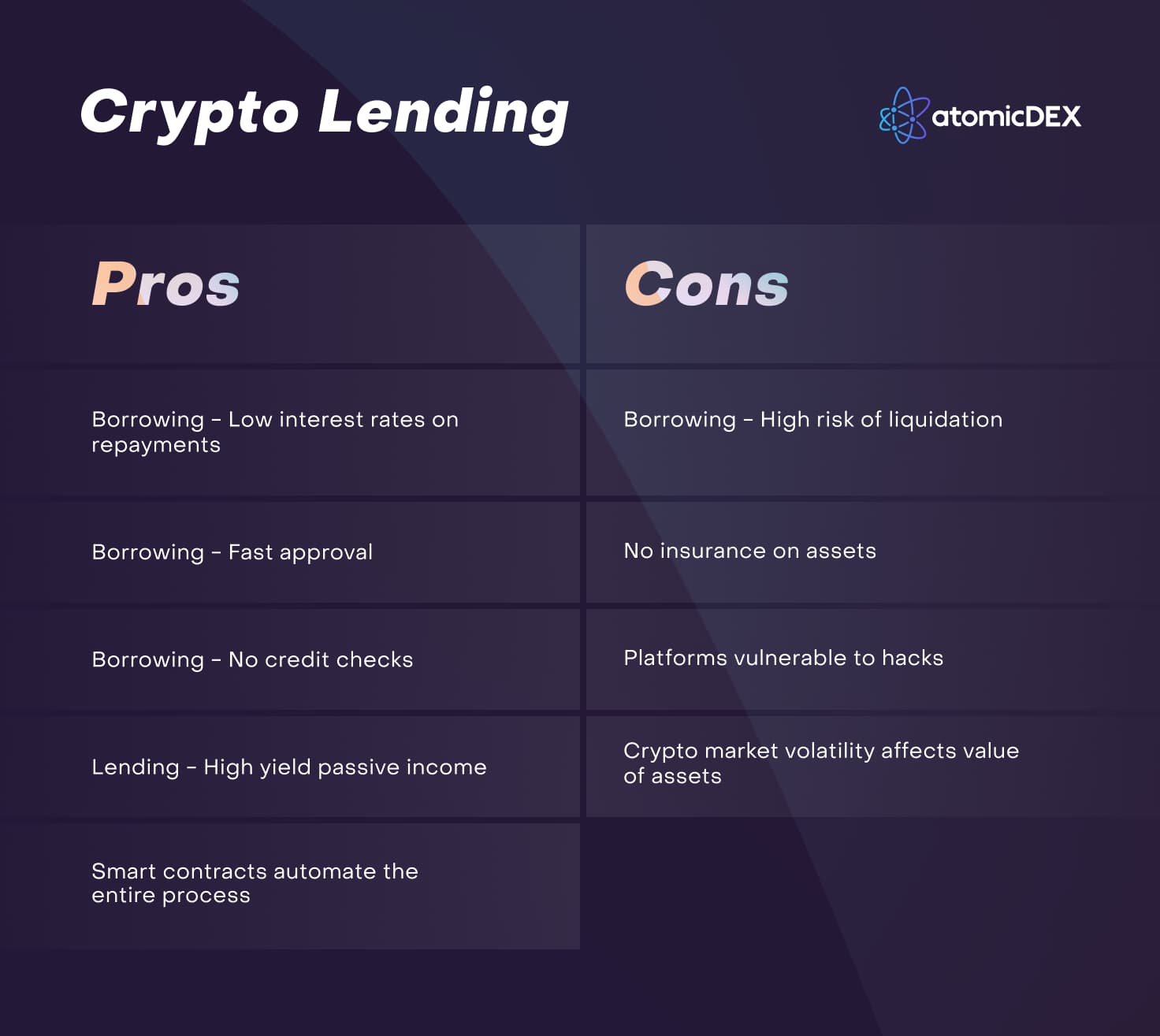
Table of contents
Cryptocurrency lending is one of many opportunities offered by the sector, where crypto holders lend their assets to borrowers to earn interest.
Crypto has caused a revolutionary shift in many conventional finance concepts. By leveraging blockchain technology, crypto has provided people with new ways to access and use many financial services. Of these new methods, crypto lending has become one of the most popular options.
Many crypto enthusiasts often hold their assets in wallets until prices appreciate. However, this practice is only profitable in a bull market. With crypto lending, crypto holders receive interest on their assets in both bull and bear markets.
What Is Crypto Lending?
Crypto lending is when investors use CeFi or DeFi platforms to lend cryptocurrencies to borrowers in exchange for interest payments. It also refers to using acquired crypto holdings as collateral to secure loans. While many centralized and decentralized crypto platforms offer lending services, interest rates vary between lenders.
How Does Crypto Lending Work?
Crypto-backed loans work like traditional mortgage loans, where holders pledge assets to obtain loans and pay off their debt over time. Crypto lending involves three parties: the lender, the borrower, and the lending service provider or application.
Firstly, the lender deposits assets to a lending pool, making the assets available to users looking to borrow. Intending borrowers then submit requests and receive assets after depositing a certain amount of crypto as agreed-upon collateral. Once the borrower receives the assets, the lender earns corresponding interest over time. Throughout the process, borrowers retain ownership of their collateral but cannot trade or use them for any transactions.
Types of Crypto Loans
There are two main types of cryptocurrency loans in the blockchain space:
- Flash loans
- Collateralized loans
Flash Loans
Flash loans allow users to borrow crypto without depositing collateral as long as the borrower returns the assets to the lending protocol in the same transaction. A flash loan requires a smart contract that contains specific instructions to release the funds and reverse the transaction if the borrower fails to pay back in the same transaction.
Collateralized Loans
Collateralized crypto loans are the most popular among cryptocurrency users. This type of loan requires borrowers to deposit crypto assets as collateral to secure the loan. Borrowers then pay back the received crypto assets over time and may only access the deposited collateral after completing the payment. Typically, borrowers can only get about 50% of their deposited collateral (and sometimes less depending on the collateralized asset). In rare cases, lenders may allow up to 90%.
Benefits of Crypto Lending
Apart from maximizing the profitability of crypto holdings, some other major benefits of cryptocurrency lending include:
Lower Interest Rates
For borrowers, interest rates on crypto loans are relatively low compared to personal loans from traditional financial institutions. Crypto lending platforms offer a cheaper and more accessible alternative to intending borrowers.
Fast Approval
Once a lender approves a crypto loan, the borrower quickly receives the assets. The transaction speed is one of the major reasons crypto loans are more efficient than traditional bank loans.
High Yield
For savers, traditional banks offer very little interest in savings accounts. Funds left in a bank for an extended period usually do not appreciate, and can easily lose their purchasing power over time due to inflation. On the other hand, crypto lending platforms offer similar saving methods but with higher interest.
No Credit Check
Unlike conventional financial institutions, crypto lending platforms do not require user credit checks (yet, at least). This helps users with poor credit scores to obtain loans. Of course, this means more collateral is then required to receive a loan.
Drawbacks of Crypto Lending
While cryptocurrency lending has many advantages over conventional bank loans, there are also a few drawbacks.
No Insurance
Unlike traditional banks where insurance covers deposited funds, the crypto lending process does not ensure assets even on centralized exchanges. Consequently, there is always the risk that users lose funds to an attack or liquidation.
Risk of Cyber Attack
All crypto lending and borrowing transactions happen over the internet. This creates a hunting ground for hackers and other illicit players to breach lending platforms and steal funds. Crypto lenders try to prevent this by using third-party security firms to audit their smart contract codes for bugs and other vulnerabilities.
Crypto Market Volatility
Volatility in the cryptocurrency market is a significant drawback for crypto lenders. The crypto asset's value deposited in a lending pool can drop significantly in a short period, leading to greater losses than the earnings from interest.
Limited Asset Support
Some crypto lending platforms only support lending and borrowing for a handful of crypto assets. These platforms restrict users to certain eligible assets, forcing borrowers to acquire those assets compulsorily.

Popular Crypto Lending Platforms and Their Rates
- BlockFi: BlockFi is a crypto lending platform that offers users collateralized crypto loans. They offer up to 3.5% APY for BTC lenders and up to 12% APY on other altcoins.
- Nexo: Nexo is a blockchain platform that facilitates instant access to crypto-backed loans. The Nexo platform offers interest rates on crypto assets of up to 16% APR, paid out daily.
- Celsius Network: Celsius Network is an all-in-one financial services platform for crypto users. The platform offers rewards for depositing cryptocurrency and provides crypto lending and borrowing services. Celsius Network pays interests of up to 12% APY. Celsius is at risk of insolvency due to potentially risky loan practices, and haven't let its users withdraw funds since June 2022. This is one of the possible downsides of crypto lending, so proceed very carefully and at your own risk.
- Aave: Aave is a decentralized cryptocurrency lending platform. The service allows users to lend and borrow crypto without any intermediary. The Aave decentralized application runs on multiple blockchains and offers two interest rates: stable and variable. The variable interest rate changes based on the demand of an asset in its lending pool. The stable interest rate is an asset's 30-day average interest rate.
- Binance: Binance is the largest cryptocurrency exchange by daily trading volume. The platform offers a variety of financial solutions, including trading, staking, and crypto-asset lending. Depending on the assets, the annual interest rates provided to lenders range between 3% and 14%. However, Binance offers better rates to lenders of its native coin (BNB) and stablecoins.
The concept of lending crypto assets to earn interest on them is a favorable practice for crypto enthusiasts. Crypto lending opens new ways for mainstream adoption of cryptocurrencies. In the long run, crypto loans could grow into one of the most lucrative aspects of the global financial sector.
Lending provides a flexible approach for borrowers to get cryptocurrency and benefit from the sector. However, crypto-based lending is still in its infancy and might take some time to gain mainstream adoption.
Try AtomicDEX — Wallet, Bridge, and DEX
To explore crypto assets and opportunities offered in the crypto space, download and set up AtomicDEX wallet.
HODL and trade BTC, ETH, BNB, KMD, and other popular cryptocurrencies from any device.




